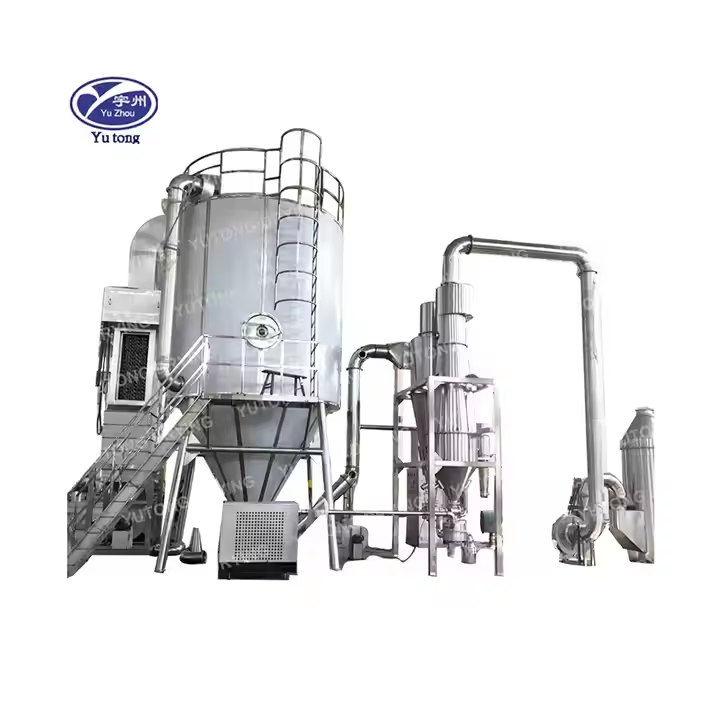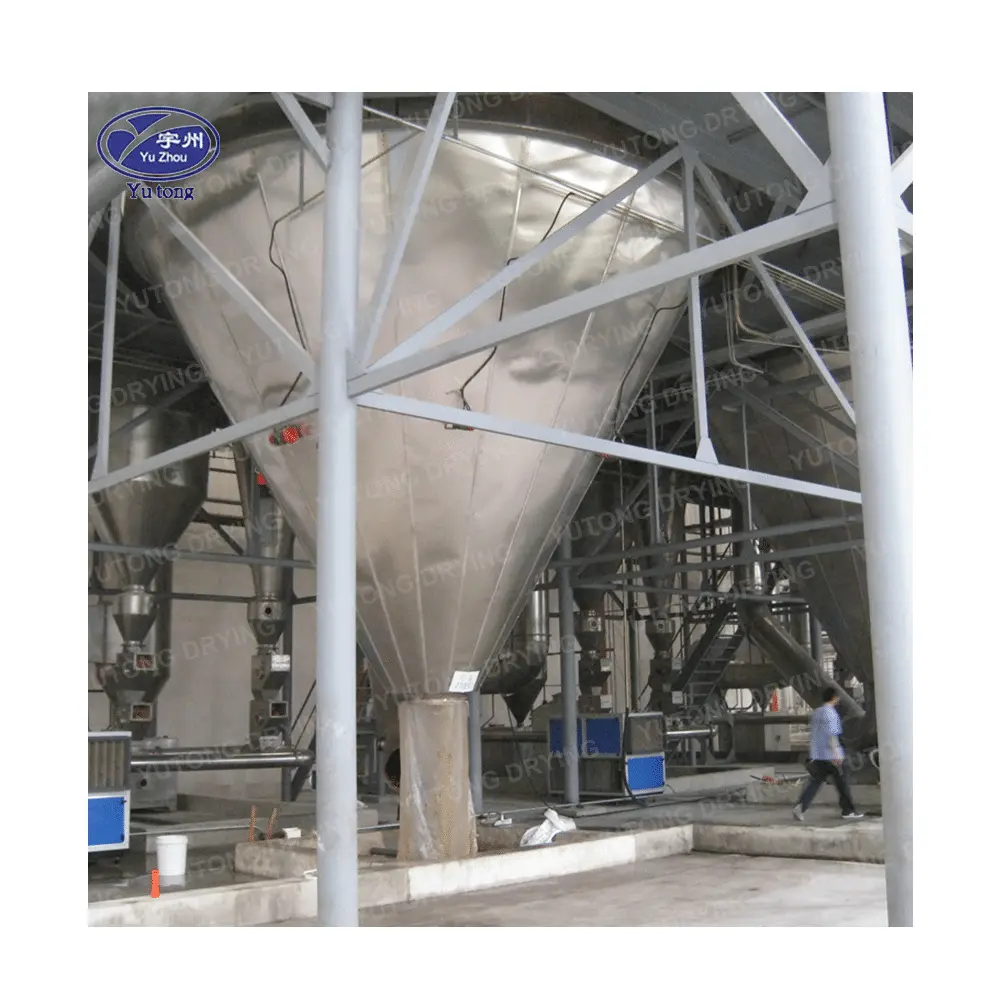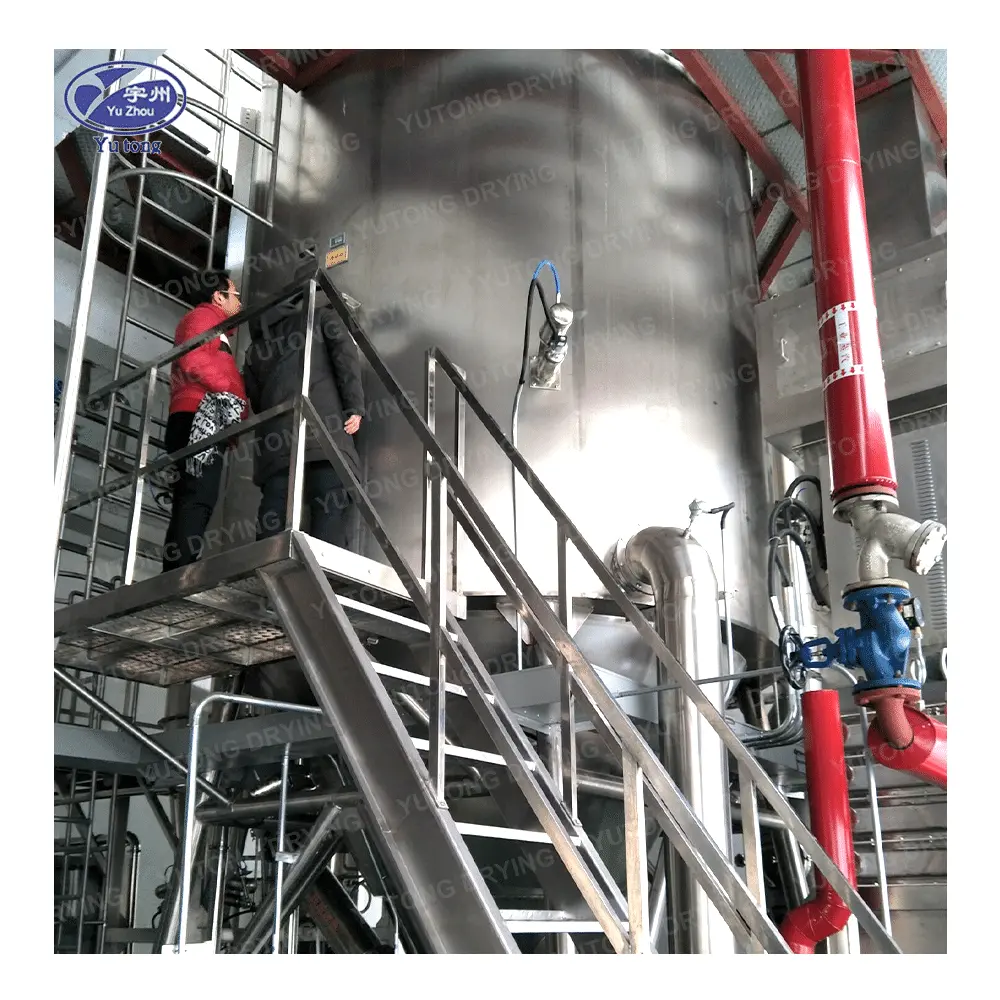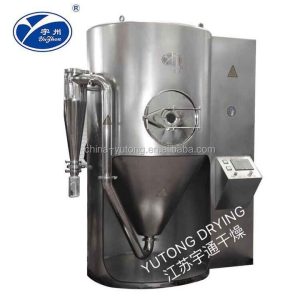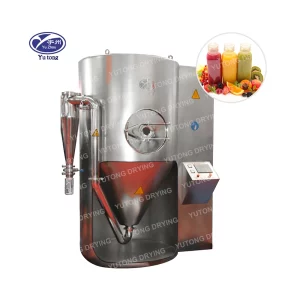Table of Contents
Product Detail
In industrial drying, spray dryers play a pivotal role in transforming liquids into powders. This catalog provides an overview of various spray drying equipment and its components, ensuring you have the information needed to choose the right equipment for your needs. As industries increasingly rely on efficient drying technologies, understanding the nuances of spray dryers becomes essential. With advancements in technology, spray dryers have become more versatile and efficient, catering to a wide range of industrial needs.
Understanding Spray Dryers
What is a Spray Dryer?
A spray dryer is a device used to convert liquids into dry powders. This is achieved by spraying the liquid into a hot drying medium, usually air, causing the solvent to evaporate and leaving behind solid particles. The result is a consistent, fine powder that can be used in various industries, from food processing to pharmaceuticals.
Spray dryers are indispensable in the production of a wide range of products. In the food industry, they are used to produce powdered milk, coffee, and spices. In pharmaceuticals, they create fine powders necessary for tablet formulation and inhalable drugs. The versatility of spray dryers allows them to cater to diverse industrial needs, making them a vital part of many production lines.
Moreover, spray dryers contribute to product preservation and shelf-life extension. By converting liquids into powders, they reduce the moisture content, thereby inhibiting microbial growth and spoilage. This aspect is particularly valuable in the food and pharmaceutical sectors, where product integrity and safety are paramount.
How Does a Spray Dryer Work?
Spray dryers operate by atomizing the liquid into tiny droplets using a nozzle or rotary atomizer. These droplets are then exposed to a stream of hot air, causing rapid evaporation. The dried particles are collected at the bottom of the drying chamber while the evaporated moisture is vented out.
The atomization process is critical as it determines the surface area available for evaporation. Smaller droplets lead to faster drying times and finer powders. The choice between nozzle and rotary atomizers depends on the desired particle size and production capacity. Each type offers distinct advantages, making it crucial to select the appropriate method for your application.
The drying chamber’s design also significantly affects a spray dryer’s efficiency. The chamber must facilitate the even distribution of hot air and prevent particles from sticking to the walls. Advanced designs incorporate features to enhance airflow and particle collection, improving overall efficiency and product quality.
The control systems in modern spray dryers allow for precise regulation of temperature, airflow, and droplet size. This precision ensures that the drying process is consistent and that the final product meets the required specifications. Operators can adjust parameters in real time, optimizing the drying process for different materials.
Types of Spray Dryers
Tall Form Spray Dryer
Tall-form spray dryers have a long, narrow drying chamber. This design allows for extended drying time and is ideal for heat-sensitive materials. The tall form ensures that particles have sufficient time to dry before reaching the bottom of the chamber.
The vertical design of tall-form spray dryers provides a longer path for the drying air, enabling a gradual temperature reduction. This feature is particularly beneficial when dealing with materials that degrade under high temperatures. By maintaining a controlled environment, these dryers preserve the quality and characteristics of sensitive products.
Additionally, tall-form spray dryers often incorporate advanced air dispersion systems. These systems ensure a uniform distribution of hot air, preventing localized overheating and ensuring consistent drying. The result is a high-quality powder with uniform particle size and moisture content.
The versatility of tall-form spray dryers makes them suitable for a wide range of applications. They are particularly popular in the dairy and food industries, where preserving flavor and nutritional content is critical. By accommodating various feed types and production scales, these dryers offer manufacturers flexibility.
Nozzle Atomizer Spray Dryer
A nozzle atomizer spray dryer uses high-pressure nozzles to break down the liquid into fine droplets. The nozzle size can significantly affect the spray dryer’s efficiency, influencing the particle size and drying rate.
The choice of nozzle type and size depends on the desired particle characteristics and production requirements. Smaller nozzles produce finer droplets, ideal for applications requiring high precision and uniformity. Conversely, larger nozzles are suited for high-capacity operations where particle size is less critical.
High-pressure nozzles in these dryers provide excellent control over droplet size distribution. This control is crucial for producing powders with specific properties, such as solubility or flowability. By adjusting the nozzle pressure, operators can fine-tune the drying process to meet diverse product specifications.
Nozzle atomizer spray dryers are particularly advantageous for applications involving viscous or sticky liquids. The high pressure helps overcome the resistance of such liquids, ensuring efficient atomization and drying. This capability expands the range of materials that can be processed using spray drying technology.
Rotary Atomizer Spray Dryer
Rotary atomizer spray dryers utilize a rotating disc to atomize the liquid. This method is suitable for high-capacity operations and can handle a wide range of liquid viscosities.
The rotating disc in a rotary atomizer creates a centrifugal force, breaking the liquid into fine droplets. This mechanism allows for high throughput, making it ideal for large-scale industrial applications. The ability to handle various viscosities also adds to the versatility of rotary atomizer spray dryers.
Rotary atomizers handle diverse feed materials and offer exceptional control over particle size distribution. By adjusting the disc speed, operators can achieve the desired droplet size and drying rate. This flexibility is beneficial for producing powders with specific characteristics, such as bulk density or moisture content.
Rotary atomizer spray dryers are often used in the chemical and detergent industries, where large volumes of product are processed daily. Their robust design and high efficiency make them a reliable choice for continuous operation, ensuring consistent product quality and minimal downtime.
Key Components of a Spray Dryer
Spray Dryer Nozzle
The nozzle is a crucial component in a spray dryer, responsible for atomizing the liquid. Different nozzle sizes and types can affect drying efficiency and particle size distribution, so it is essential to select the appropriate nozzle for your specific application.
The precision and quality of the nozzle directly impact the final product. High-quality nozzles ensure uniform droplet formation, leading to consistent drying and powder characteristics. Selecting the right nozzle material is also essential, as it must withstand the operational pressures and temperatures without degrading.
Maintenance of the nozzle is critical to ensure long-term performance and efficiency. Regular cleaning and inspection prevent clogging and wear, which can compromise the drying process. Many modern spray dryers feature self-cleaning nozzles, reducing maintenance requirements and downtime.
Nozzle technology continues to evolve, with innovations aimed at improving atomization efficiency and reducing energy consumption. Advanced designs incorporate features such as adjustable spray angles and variable flow rates, offering greater control over the drying process. These innovations enhance the versatility and adaptability of spray dryers.
Nozzle Gasket and O-Ring
The nozzle gasket and O-ring ensure a tight seal between the nozzle and the drying chamber, preventing leaks and maintaining consistent pressure. To ensure optimal performance, these components must be regularly inspected and replaced.
The integrity of the gasket and O-ring is vital for maintaining pressure within the system, which is crucial for efficient atomization. Any leaks can lead to pressure drops, affecting the quality of the spray and the final product. Routine checks and timely replacements are essential to prevent such issues.
Materials used for gaskets and O-rings must withstand the spray dryer’s operational conditions, including temperature fluctuations and chemical exposure. Selecting the right material ensures durability and longevity, reducing the need for frequent replacements and minimizing maintenance costs.
Innovations in gasket and O-ring materials focus on enhancing resistance to wear and chemical degradation. Advanced materials offer improved sealing properties and longer lifespans, contributing to the spray dryer’s overall reliability and efficiency. By investing in high-quality components, operators can ensure consistent performance and product quality.
Spray Dryer P&ID
A Process and Instrumentation Diagram (P&ID) is a detailed representation of the spray dryer’s process flow and instrumentation. It provides critical information for the equipment’s operation, maintenance, and troubleshooting.
The P&ID serves as a roadmap for understanding the complex interactions within the spray dryer. It outlines the flow of materials and air, the placement of sensors and control devices, and the connections between different components. This information is essential for optimizing performance and diagnosing issues.
Operators rely on the P&ID to ensure proper setup and configuration of the spray dryer. It guides them in adjusting parameters and making modifications to improve efficiency and product quality. By providing a comprehensive overview of the system, the P&ID facilitates informed decision-making and enhances operational effectiveness.
In addition to aiding daily operations, the P&ID is invaluable for maintenance and troubleshooting. It helps identify potential problem areas and guides technicians in locating and resolving issues. Regular updates ensure that the P&ID remains an accurate and valuable tool for managing the spray drying process.
Popular Spray Dryer Brands
Yamato Spray Dryers
Yamato offers a range of spray dryers, including the GB210B model, which is widely used for laboratory applications. The Yamato spray dryer manual provides detailed instructions for setup, operation, and maintenance.
Yamato’s reputation for quality and innovation makes its spray dryers a popular choice among researchers and small-scale producers. The compact design and user-friendly interface of their laboratory models facilitate easy operation and precise control, making them ideal for experimental and pilot-scale applications.
The GB210B model is particularly noted for its versatility and adaptability. It accommodates a wide range of feed materials and drying conditions, allowing users to conduct diverse experiments and optimize formulations. Its robust construction and advanced features ensure reliable performance and consistent results.
Yamato provides comprehensive support and resources for their spray dryers, including detailed manuals and technical assistance. This support enhances user confidence and ensures that operators can maximize the potential of their equipment. By choosing Yamato, users benefit from a combination of cutting-edge technology and exceptional customer service.
SACMI Spray Dryers
SACMI is known for its high-capacity spray dryers designed for industrial applications. Their equipment is renowned for its durability and efficiency, making them a popular choice in various sectors.
SACMI’s industrial spray dryers are engineered for large-scale operations, delivering high throughput and consistent quality. Their robust design and advanced features ensure efficient drying and minimal downtime, making them ideal for demanding industrial environments.
The durability of SACMI spray dryers is a key advantage, as it minimizes maintenance requirements and extends the equipment’s lifespan. This reliability translates to cost savings and enhanced productivity, as operators can focus on production without frequent interruptions for repairs.
In addition to their performance, SACMI spray dryers are known for their energy efficiency. Advanced control systems optimize energy consumption, reducing operational costs and environmental impact. This focus on sustainability aligns with industry trends and regulatory requirements, making SACMI a forward-thinking choice for modern manufacturers.
Ohkawara Spray Dryers
Ohkawara specializes in spray dryers for the food and pharmaceutical industries. Their designs focus on energy efficiency and product quality, ensuring reliable performance.
Ohkawara’s commitment to energy efficiency is evident in its innovative designs, which incorporate features to minimize energy consumption without compromising drying performance. This focus on sustainability is significant for industries with high energy demands, such as food and pharmaceuticals.
Product quality is a top priority for Ohkawara, and their spray dryers are engineered to deliver consistent and high-quality powders. Advanced control systems ensure precise regulation of drying parameters, resulting in uniform particle size and moisture content. This consistency is critical for maintaining product integrity and meeting industry standards.
Ohkawara provides comprehensive support and customization options to meet its clients’ unique needs. By collaborating closely with customers, it delivers tailored solutions that optimize performance and efficiency. This customer-centric approach has earned Ohkawara a reputation for excellence and reliability in the spray drying industry.
Spray Dryers from Japan
Japan is home to several leading spray dryer manufacturers known for their innovative designs and advanced technology. Japanese spray dryers are favored for their precision and reliability.
Japanese manufacturers are renowned for their commitment to quality and innovation, and their spray dryers reflect these values. By incorporating cutting-edge technology and meticulous engineering, they deliver equipment that meets the highest standards of performance and reliability.
Precision is a hallmark of Japanese spray dryers, with advanced control systems enabling precise regulation of drying conditions. This precision ensures that the final product meets the desired specifications, enhancing product quality and consistency. For industries where accuracy is critical, Japanese spray dryers are a preferred choice.
In addition to their technical excellence, Japanese spray dryers are known for their durability and longevity. Built with high-quality materials and components, they offer reliable performance and minimal maintenance requirements. This combination of precision and reliability makes Japanese spray dryers a valuable investment for manufacturers worldwide.
Choosing the Right Spray Dryer
When selecting a spray dryer, consider the following factors:
- Material Properties: The properties of the material to be dried, such as viscosity and heat sensitivity, will influence the choice of dryer and atomizer type.
Understanding the material properties is crucial for selecting the appropriate spray dryer and atomizer. Viscous or sticky materials may require specific atomization techniques, while heat-sensitive substances benefit from designs that minimize thermal exposure. By analyzing these characteristics, manufacturers can ensure optimal drying performance and product quality.
The chemical composition of the material also affects the choice of spray dryer. Corrosive or reactive substances necessitate materials and coatings resistant to chemical attack. By selecting equipment tailored to the material’s properties, operators can prevent degradation and ensure safe and efficient drying.
- Capacity Requirements: Determine the required production capacity and choose a spray dryer that can meet these needs.
Accurate assessment of capacity requirements is essential for selecting a spray dryer that aligns with production goals. Overestimating capacity can lead to unnecessary costs, while underestimating it may result in bottlenecks and inefficiencies. By evaluating current and projected demand, manufacturers can choose equipment that supports growth and scalability.
Flexibility in capacity is also a consideration, as production needs may fluctuate over time. Some spray dryers offer adjustable throughput, allowing operators to adapt to changing requirements. This adaptability ensures that the equipment remains efficient and cost-effective, even as production demands evolve.
- Energy Efficiency: Opt for a spray dryer with energy-saving features to reduce operational costs.
Energy efficiency is a critical factor in a spray dryer’s overall cost-effectiveness. Equipment with energy-saving features, such as heat recovery systems and optimized airflow, can significantly reduce operational expenses. By minimizing energy consumption, manufacturers not only save on costs but also reduce their environmental footprint.
The integration of advanced control systems enhances energy efficiency by allowing precise regulation of drying parameters. These systems optimize the use of energy, ensuring that it is directed where needed most. This precision reduces waste and contributes to the overall sustainability of the production process.
- Maintenance and Support: Consider the availability of spare parts and technical support for the chosen brand and model.
Reliable maintenance and support are essential for a spray dryer’s long-term performance. The availability of spare parts and technical assistance ensures that equipment can be promptly serviced and repaired, minimizing downtime. By choosing a brand with a robust support infrastructure, manufacturers can maintain consistent production and product quality.
Proactive maintenance strategies, supported by the manufacturer, further enhance equipment reliability. Regular inspections and scheduled servicing prevent issues before they arise, extending the spray dryer’s lifespan. By investing in comprehensive support, operators can achieve optimal performance and cost savings.
Conclusion
Spray dryers are essential in various industries, offering efficient and consistent drying solutions. This catalog provides an overview of different spray drying equipment and components, helping you make informed decisions when selecting the right spray dryer for your needs. Whether you’re looking for a tall-form spray dryer, a nozzle atomizer, or a rotary atomizer, understanding the key features and considerations will ensure you choose the best equipment for your application. As technology continues to advance, spray dryers will play an increasingly vital role in industrial processes, driving innovation and efficiency across sectors.
Specifications
|
spec
|
ZPG-25
|
ZPG-50
|
ZPG-80
|
ZPG-100
|
ZPG-150
|
ZPG-200
|
ZPG-300
|
|
|
evaporation capacity(kg/h)
|
25
|
50
|
80
|
100
|
150
|
200
|
300
|
|
|
process amount of material liquid(kg/h)
|
25-34
|
50-68
|
80-108
|
100-135
|
150-203
|
200-270
|
300-406
|
|
|
output of finished pcoduct(kg/h)
|
4.8-7.2
|
9.2-14
|
14.8-22.4
|
18.4-28
|
24-42
|
36.8-56.4
|
55-85
|
|
|
solid content of material liquid( %)
|
18-30
|
|||||||
|
moisture content of finished product( %)
|
3-5
|
|||||||
|
electric power(kw)
|
63
|
132
|
153
|
204
|
246
|
330
|
||
|
heat source
|
Steam pius electricity
|
|||||||
|
Collecting method of product and its efficiency
|
Grade one or two or three stage cyclone wet dust remover is greater than or equal to 95%
|
|||||||
|
automatic control meters and instruments
|
indicator of not air and exhaust air temperature
|
|||||||
|
temperature of air inlet(℃)
|
160-220
|
|||||||
|
temperature of air outlet(℃)
|
80-100
|
|||||||
|
L
|
7000
|
8000
|
9800
|
11000
|
12200
|
14100
|
15000
|
|
|
overal dimensions(mm)
|
W
|
4000
|
5000
|
5700
|
6200
|
7000
|
7800
|
9000
|
|
H
|
6200
|
6900
|
8000
|
8900
|
10750
|
11900
|
13000
|
|
Applications
No Content Matching Your Selection Is Found.

